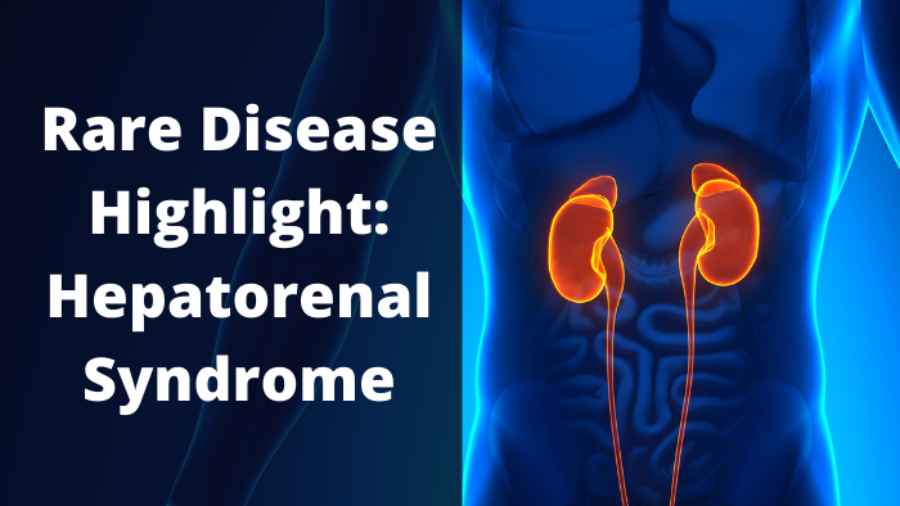Hepatorenal syndrome (HRS) is a serious complication in patients who have decompensated cirrhosis, an advanced liver disease characterized by decreased functioning of the organ. It involves extreme circulatory dysfunction in the liver and a reduction in renal blood flow leading to further dysfunction of the kidneys (Bucsics et al., 2017; Mindikoglu et al., 2018). Patients with HRS have a poor prognosis and high mortality, with patients surviving from several months to only weeks in most cases.
HRS presents with symptoms of severe liver failure which may be accompanied by infections or sepsis (Nayak et al., 2017). In addition, patients with a severely reduced glomerular filtration rate (GFR) over a 2 day period are diagnosed with acute kidney injury (AKI) (Mindikoglu et al., 2018). As the liver’s functionality decreases, the patient becomes more likely to bleed, develop blood clots, and in some cases can develop jaundice. Patients also experience ascites, which is a gradual buildup of fluid within the peritoneum, the tissue lining the abdominal wall covering the visceral organs (Nayak et al., 2017; Ranasinghe et al., 2017). Finally, a severe sign of HRS is mental impairment resulting from hepatic encephalopathy arising from the inability of the liver to metabolize toxins (Nayak et al., 2017).
Although the current mechanism of HRS is not fully understood, the most widely accepted explanation is known as the peripheral arterial vasodilation theory. In short, as cirrhosis causes vasodilation in visceral blood vessels, the prolonged disruption to blood flow to the liver and kidneys eventually causes HRS in conjunction with cirrhotic liver damage (Low et al., 2015). Vasodilation reduces the body’s mean arterial pressure (MAP), which induces the release of norepinephrine to increase cardiac output and the release of vasopressin and aldosterone to induce vasoconstriction. As a result, the kidneys are forced to abnormally retain water and also receive a lower volume of blood, leading to damage and development of HRS and AKI (Acevedo et al., 2017; Arroyo et al., 1996; Garcia-Tsao et al., 2008).
The current standard of care for HRS involves treatment with 1g/kg of albumin for plasma volume expansion, followed by the addition of a vasoconstrictive drug to counteract the systemic vasodilation. HRS has the potential for reversal with timely and proper treatment if the kidneys are still functional (Nayak et al., 2017). However, due to its poor prognosis, patients are also evaluated for immediate liver transplantation (LT). LT is the definitive treatment for patients, while vasoconstrictor therapy acts as a supportive therapy pre-transplant. A small portion of HRS patients with severe kidney damage unresponsive to medical treatment resort to hemodialysis while awaiting LT, significantly impacting their day-to-day life (Acevedo et al., 2017; Gines et al., 1999). LT surgery may further impair renal function, and about one-third of HRS patients continue dialysis. In addition, transplant patients with HRS have more complications, and must stay in intensive care longer than non-HRS transplant patients. They also have a higher in-hospital mortality rate than transplant patients without HRS (Gines et al., 1999).
References:
- Acevedo, J. G., & Cramp, M. E. (2017). Hepatorenal syndrome: Update on diagnosis and therapy. World Journal of Hepatology, 9(6), 293-299. doi:10.4254/wjh.v9.i6.293
- Arroyo, V., Gines, P., Gerbes, A. L., Dudley, F. J., Gentilini, P., Laffi, G., . . . Scholmerich, J. (1996). Definition and diagnostic criteria of refractory ascites and hepatorenal syndrome in cirrhosis. International Ascites Club. Hepatology, 23(1), 164-176. doi:10.1002/hep.510230122
- Bucsics, T., & Krones, E. (2017). Renal dysfunction in cirrhosis: acute kidney injury and the hepatorenal syndrome. Gastroenterology Report, 5(2), 127-137. doi:10.1093/gastro/gox009
- Garcia-Tsao, G., Parikh, C. R., & Viola, A. (2008). Acute kidney injury in cirrhosis. Hepatology, 48(6), 2064-2077. doi:10.1002/hep.22605
- Gines, P., & Arroyo, V. (1999). Hepatorenal syndrome. J Am Soc Nephrol, 10(8), 1833-1839.
- Low, G., Alexander, G. J. M., & Lomas, D. J. (2015). Hepatorenal Syndrome: Aetiology, Diagnosis, and Treatment. Gastroenterology Research and Practice, 2015, 207012. doi:10.1155/2015/207012
- Mindikoglu, A. L., & Pappas, S. C. (2018). New Developments in Hepatorenal Syndrome. Clinical Gastroenterology and Hepatology, 16(2), 162-177.e161. doi:10.1016/j.cgh.2017.05.041
- Nayak, S. L., Kumar, M., Bihari, C., & Rastogi, A. (2017). Bile Cast Nephropathy in Patients with Acute Kidney Injury Due to Hepatorenal Syndrome: A Postmortem Kidney Biopsy Study. Journal of Clinical and Translational Hepatology, 5(2), 92-100. doi:10.14218/JCTH.2016.00063
- Ranasinghe, I. R., & Bhimji, S. S. (2017). Hepatorenal Syndrome. In StatPearls. Treasure Island (FL): StatPearls Publishing LLC.
BioPharma Global is a mission-driven corporation dedicated to using our FDA and EMA regulatory expertise and knowledge of various therapeutic areas to help drug developers advance treatments for the disease communities with a unmet medical needs. If you are a drug developer seeking regulatory support for Orphan Drug designation, Fast Track designation, Breakthrough Therapy designation, other FDA/EMA expedited programs, type A, B (pre-IND, EOPs), or C meeting assistance, or IND filings, the BioPharma Global team can help. Contact us today to arrange a 30-minute introductory call.
Stock image by decade3d

